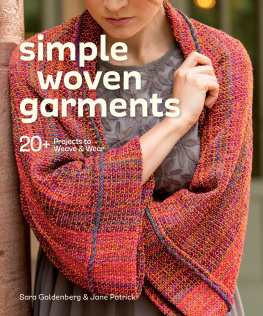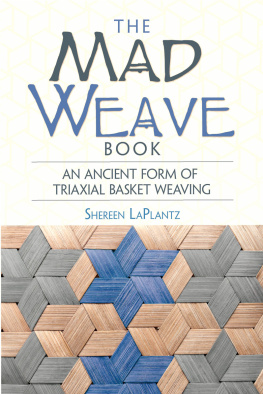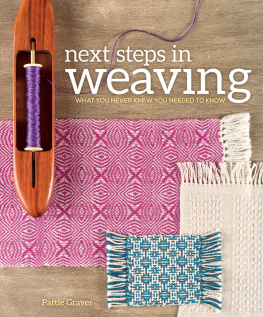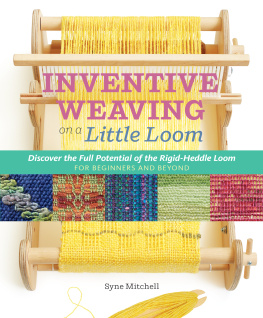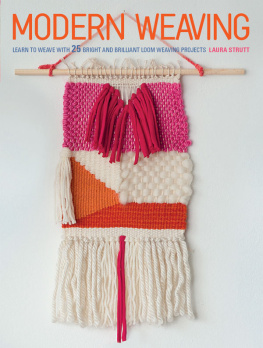Contents
Guide
20+ Projects to Weave & Wear
Sara Goldenberg & Jane Patrick

CONTENTS
Garments
Introduction
We wanted to write this book because we think new weavers (and experienced ones, too) are ready to launch into garment making. We thought that by providing some appealing designs that are easy to weave and sew, we could offer the information you need to create garments on your own with confidence.
All of these garments are made from simple designs. In designing each garment, we considered both the fabric and the garment construction. First, we wanted to design a fabric that worked for the intended use. And second, we strove to design garments that require simple construction and no buttonholes or zippers. You dont have to be a couture seamstress to sew these garments.
We know that it is a tricky and sometimes frightening thing to cut into your precious handwoven fabric. What if I cut in the wrong place? What if the fabric ravels? What if the garment doesnt work? We kept these questions in mind as we planned the projects. We also hope that weve provided all the supplementary information youll need to weave and sew with self-assurance.
Weve assumed that you know how to warp your loom and have a bit of weaving experience. The reader we have in mind is one who is an advanced beginner to expert weaver, knits a lot or a little, and knows how to sew a seam on a sewing machine.
We havent labeled the projects as rigid-heddle or shaft loom, but we have sampled and woven projects on both rigid-heddle and shaft looms. Our goal was to make the projects approachable for either kind of loom, and we have tested projects to the point that we feel confident that these pieces can be woven on either a shaft or rigid-heddle loom.
Sara is an expert and experienced sewer, and I can barely sew a seam. Our litmus test was: If Jane can sew it, anyone can. This directed much of the garment design. Youll find that most garments have very few pieces and seams. Only two projects have any serious amount of sewing and even then the sewing is Jane proof. To add shaping, we sometimes used knittingcollars, cuffs, and at the waist. We also employed some weaving techniques, such as pulled warps or sewing in a drawstring, to add shaping at the shoulders and waist.
Youll find a broad range of yarns, primarily knitting yarns, in the projects. Even though it is often stated that you cant use knitting yarns for weaving, we were quite successful with all of the yarns used here. We would broadly say that when using knitting yarns for weaving, you need to be aware that some yarns are going to have a lot of stretch. Because there is less tension on a rigid-heddle loom, the stretchiness of a yarn is not as important a consideration as when using the same yarn on a shaft loom.
We have had a blast working on this book together, and we hope that these ideas will spark your own and launch you on a mission to weave, weave, weave.
On Our Collaboration
It is joyous to collaborate on a project. But to be fully harmonious, the parties must be able to have honest discourse, like each other, live up to their part of the project (pull their own weight), and trust and respect each other. Having a similar vision and aesthetic doesnt hurt, either. If what Ive just said is true, and in regard to this project Id say it is, then creating a book together is a special and wonderful experience indeed.
It has been especially fun to work with Sara, even thrilling from time to time when we shared an idea or clipping from a magazine to find that we were both tracking along the exact same lines. Sara has lent her sense of style and design to the creation of these garments, as well as her sewing expertise. She comes with credentials, too: an MFA in fibers from CSU in Fort Collins, Colorado. Sara is an exhibited artist, and many of her forms are sculpturalwhich helps when thinking about designing for the body. Her art training in both sculpture and textiles shines through in the way she masters form and color.
Ive lent years of weaving as well as my experience as a past editor of Handwovenwhich is where I learned so much from the magazines contributorstruly deepening my weaving vocabulary in profound ways. Ive also been responsible for the writing and material development for this book.
I first met Sara when she was a student at CSU. I had contacted her professor, Tom Lundberg, looking for a summer intern. He sent me Sara, in part because she also lived in Boulder. Even though Sara was busy with her masters studies, she agreed to work with me every morning for a summer. Spending that much time with a person could be a trial, but our working together was most compatible and pleasurable. I really loved working with Sara, and I think she felt the same way about working with me. When I thought of the idea of making this book, I knew Sara was the one to make it happen.
From both of us, we hope youll soon be wearing something handwoven, inspired by what you find herein.
Jane Patrick
How to Use This Book
Weve organized the projects loosely by difficulty, beginning with our V Shawl, which is just two rectangles sewn together at right angles, and ending with our Swing Top, a design that requires cutting, shaping, and sewing of several pieces. In between are mostly rectangles sewn together into a variety of configurations or embellished in some way such as sewing a long ruffled strip around the sides of a rectangle for our Starry, Starry Night Shawl.
Each project includes an overview and complete weaving, finishing, and assembly instructions, as well as assembly illustrations and ideas for interpreting a project in other ways. While weve given particular instructions for the designs shown, we also want you to feel free to vary our ideas to create your own unique wearables.

